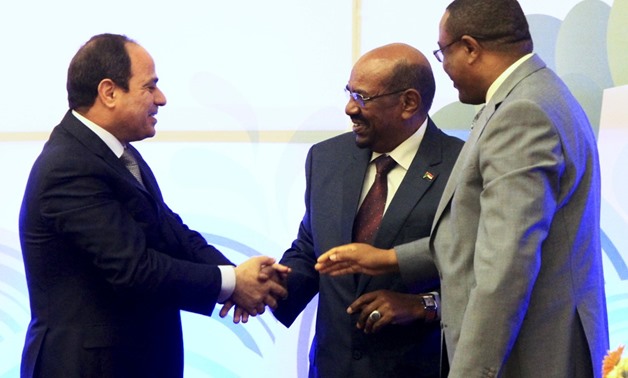
Egypt’s President Abdel Fattah al-Sisi, left, with his Sudanese counterpart, Omar Hassan al-Bashir, center, and the Ethiopian Prime Minister Hailemariam Desalegn. Photograph: Mohamed Nureldin Abdallah/Reuters
CAIRO – 16 November 2017: The disagreement by Ethiopia, Sudan, and Egypt earlier this week upon the guidelines indicated in the technical studies to inhibit potential adverse consequences, which will result from building the Renaissance Dam, triggered demands by Egyptian writers to file complaint with the United Nations.
The same suggestion was raised by Hisham Magdy, member of the parliament's African Affairs Committee, on Thursday. However, parliamentarians in charge of the file set four main dimensions on Tuesday to handle the issue excluding legal procedures. Political experts also preferred to make litigation the least option.
Recommendations by international law and African affairs experts
Ayman Salama, international law professor at Cairo University, told Masrawy on Tuesday that there are three options Egypt can attempt before resorting to the United Nations. The first option is holding direct negotiations with Ethiopia to halt constructions in the dam until an agreement is reached.
The second is seeking the mediation of state leaders and international organizations. The third is holding talks by the leaders of Egypt, Sudan, and Ethiopia in case of the failure of all other solutions.
That last proposition was also mentioned by Momtaz el-Dessouky, member of the Legislative Committee at the parliament, saying that the crisis must be solved on the political leadership level of the three countries.
The chairman of the Institute of African Studies and Research, Ayman Shabana, Ph.D., shared the same opinion on the two last points as he said in a TV phone call that the three leaders must set a timeline for negotiations, and that Gulf countries can assume mediation depending on their economic influence in Africa.
International law professor Mosaed Abdel Aty said in a TV phone call that Egypt can file a complaint in the Security Council which is entitled - based upon Articles 33, 36, and 38 of the Charter of the United Nations - to “call upon the parties to settle” disputes peacefully and avoid endangering the “maintenance of international peace and security.”
The Security Council can also recommend that parties involved refer the dispute to the International Court of Justice, in accordance with the provisions of the Statute of the Court.
Recommendations by parliamentarians
Parlmany, news website, reported on Tuesday the main points parliamentarians, following up with the Renaissance Dam file, agreed upon for future handling of the crisis. They settled on the necessity of a strategy to cooperate with African countries, especially Nile Basin ones, in developmental projects, as well as encouraging the Egyptian private sector to invest in those markets.
Furthermore, they emphasized that Sudan must be treated as a beneficiary from the dam because of its ambitions to benefit from the electricity that the dam will generat. Parliamentarians in charge of the file also stipulated on the importance of diplomacy in clarifying to the international community repercussions of building the dam in the current capacity, and filling its reservoir over three years instead of seven.
The mediation suggestion proposed by experts was also raised by these parliamentarians, highlighting that Egypt’s allies can cooperate with Ethiopia in different domains with the goal of influencing it to take a lenient stance on the issue.
Information on the dam and impact on Egypt
Constructions in the Grand Renaissance Dam started on April 2, 2011 at a cost of $4.8 billion. It was built by the Italian construction and engineering company Salini Impergilo. The Italian company is headquartered in Milan. The dam is located on the Blue Nile with a capacity of 74 billion cubic meters, and is expected to generate up to 6,000 megawatts of power.
Since May 2011, Cairo has voiced its concern over how the dam can reduce the country’s annual shares of more than 56 billion cubic meters of Nile water. Egypt’s average water per-capita is expected to drop from 663 cubic meters per year to 582 cubic meters by 2025, according to the Central Agency for Public Mobilization and Statistics (CAPMAS) in 2014. Addis Ababa, however, claimed that the dam is necessary for its development and will not harm downstream countries.
Meanwhile, President Abdel Fatah al-Sisi signed a tripartite joint cooperation agreement in Khartoum on March 23, 2015 between Egypt, Sudan, and Ethiopia. In December 2015, Sisi addressed the public, saying that there is no reason to worry about the dam and that the matter would be resolved. The three countries held 14 rounds of consultation on resolving the disputes over the Renaissance Dam. However, these rounds failed to solve the dispute.
Former Egyptian Minister of Water Resources and Irrigation, Hossam el-Moughazi, stated in November 2015 that the dam’s construction is going faster than the tripartite talks. On October 1, The Telegraph reported that Ethiopia is finalizing the construction of the dam and then will start filling its reservoir.


Comments
Leave a Comment